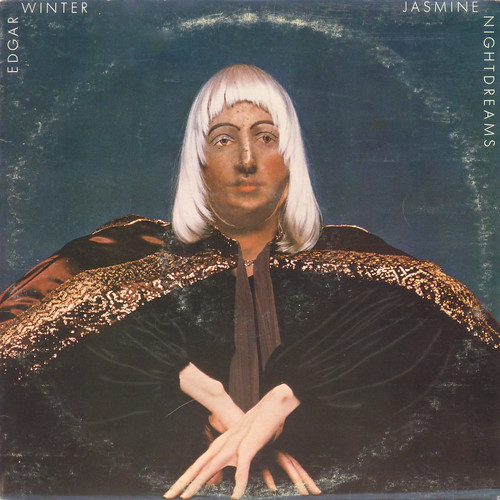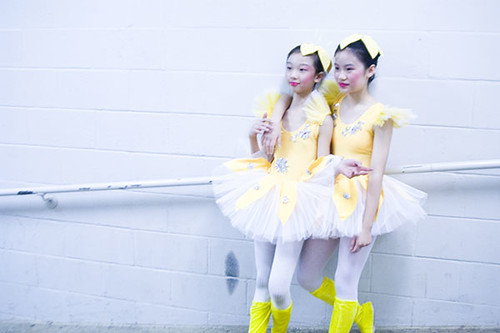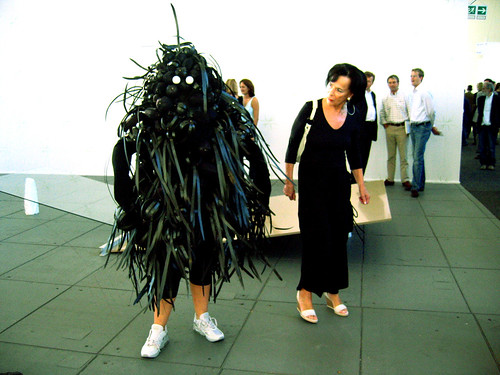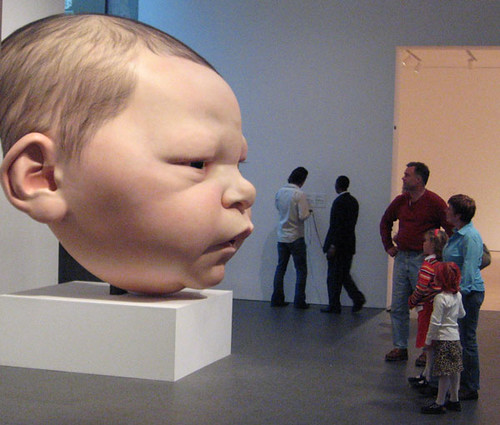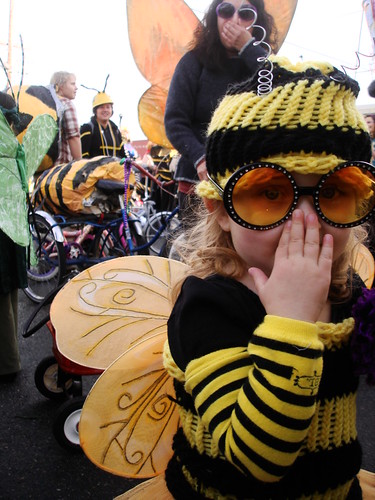Some found flickr images curated together from several different photographers/artists/sources. Click on any image to take you to its source.
Someday we'll be truckers
Ruby gave me original words, the hard to take kind. She had been gang raped the night before I met her and photographed her. She had this sweetness, this naive kindness that just sort of came out of her despite the bruises... she was as a child, and hurting her seemed to be the most devilish thing imaginable, like hurting a child. I wanted to hurt them, burn them, rip out their kidneys while their hearts still beat, pull off their dicks with those chains on the back of trucks you take big stumps out with, and then make them eat it with wasabi.
I wanted to hold her, comfort her and tell her how it would be someday, because:
Someday we'll be truckers. We'll wear cowboy hats, the kind with the big feather bands, and all sorts of clothes that remind us of Cannonball Run. We'll have those birds like on TransAms and they'll be on our clothes, maybe tattoos of them. We'll wink at people as we drive by in our great big loud truck and maybe we'll honk. Maybe. The honking will make us think of that arm-pumping some people like to do when they say "YYYYYYYYeeeeesssssss!" That's why it's good to be a trucker. And the outlaw country. We'll meet Steve Earle and he will know us, just know us, the way kindred spirits do. We'll sing along with Billy Jo Shaver songs, and we'll really believe them. We'll specifically listen to "I'm gonna live forever," but we'll definitely prefer the version made after his son died and his wife left, because we know him in that one, just know him.
Someday we'll live in Annie Dillard novels. We'll frolic by streams and we'll poke things with sticks and we'll know nature like it's a part of us or something. We'll dance and sing and make up adventures and we'll find one of those rocks like in Romancing the Stone and with it buy a boat, a really big boat with sails.
Someday we'll be electricians. We'll have a very satisfactory thing going, what with me never having to do retail or food service again, and you never having to suck anyone's dick again. We'll know something when we know electricity, and I don't know how to explain it, but I figure there are some secrets there, secrets people who are not electricians cannot understand. We'll laugh and play; we'll be fearless, because we'll know electricity like it's a part of us or something. It will be like a big pillow fight party but with a lot of lighting and 10 billion volts.
Someday we'll be magic.
Flickr Curations
You can click on any image above, or any image on my blog, to take you to the flickr photostream of (most often) the photographer. My lack of giving each and every photographer a written link is not a sleight, just a matter of curation.
"I came to get down"

Meeeeeee tooooooooooooooooooooooooooooooooooo!!! It's like they're reading my mind. A while ago I became convinced that I was always being video taped and watched. Because every book they write is about me, every song they sing too, and every piece of art is about me too, except the ones in Chelsea which, actually, I can't comprehend or begin to fathom. I don't think they're about anyone, but maybe someone's ego. Either way, I can't concern myself with that because my life raft is too small and the cameras on me all the time consume me with my own ego. I do things to entertain the cameras because I know one thing: if I'm a show, I better have good ratings.
I didn't know how to deal with all that pressure, the cameras, the boom in the frame, the ratings, the fact that the whole world centers around everything I do, and all the books written since my show first aired on April 2, 1976 at 11:15pm, or maybe a little earlier, mom said the doctor had to leave the Elks club, but he was a drunk, so it could have been earlier or later, and all the songs made have been made about me. It was a lot to take until Jim Henson began directing my dreams. Henson knows something and he and Charlotte Salomon and Shakespeare have been talking about things and comparing notes. They talk about life being theater, and Jim was nice enough to let me in on it.
He made these huge bees, bees made of old shag carpet, because that must be all they have in heaven for crafting, because truth be told, it wasn't very well made. Henson's bastard bee sons were following--no chasing-- me on these fishing line strings, jumping and bouncing at me in impossible ways. I ran really slow so they'd be able to keep up and I grimmaced quite a lot, and it helped that the crew was so fucking incompetent that the boom, I could tell, was in the frame. So I grimmaced at the boom holder and made those movements with my eyes like "get the boom out of the frame" and he didn't catch on.
I got to an Olympic sized public-style pool in the middle of a field in the middle of nowhere and jumped in to save myself, knowing it was all a joke -- this film crew, these bees, this fear, looking through chlorinated water at how things are so different from here, so much better in the bright blue womb, where it's quiet and we know things.
Martin Parr
After finishing grad school, I went to London for a bit to intern with Martin Parr. As kind and generous a person as I've ever met, Martin showed up at the office now and then to offer gifts to the staff (three of us). What do you want, he'd ask me, to which I always replied, It's A Small World, the original one! To which he'd always say, what BESIDES that? (The original is out of print and super collectible and muey expensive).
He agreed to look through my images, and the genius of Martin is that he sort of tricks you into critiquing your own work. Everything is in the form of a question, and pretty soon you realize you had already had the answers you were looking for.
After seeing my photos, he showed up in the office the next time with a copy of Rinko Kawauuchi's 'Aila' book for me. He handed it to me, and said, "She's a GENIUS." He was right. Aila is fantastic, hard to get ahold of, and highly recommended.
Parr is an uber photography book collector, and his Bristol home is apparently filled to the gills with photo books. "You can't see the walls, because it's stacks of books, everywhere," his assistant, Conor, told me.
My assignment, during my three months there, was to catalog every single negative in Parr's massive collection. If you know how prolific this guy is, this was a task to say the least. I sort of guffawed at the undertaking. The best part was in witnessing his process. Parr doesn't take one picture of anything. He's a monster of taking everything from every possible angle, in every way he can imagine. The other super magical thing about seeing his work in this form was seeing the beginnings of his relationship with his wife. All these images, unseen by even the most avid collector, but seen by me (how lucky I am!) were photographs of them falling in love. You could see it in the way he photographed her, and in her return gaze. Magic.
The other crazy thing I found were several photographs of a friend of mine at Paris Las Vegas. She and I had worked together there for two years; she'd even helped me get my next job at Mandalay. I'd never even known she'd met Martin, let alone been photographed by him. There I'd been, waitressing in a coffee shop in horrific faux Paris, one degree of separation from the great Parr, with no knowledge of it whatsoever. Weird, sometimes everything's soooo Kevin Bacon.
A stranger, Ukraine
More beautiful photographs from the Ukraine, this time by a Canadian. Most of the images on his flickr stream are of strangers. That's sort of the thing about photography though, the excuse to get nearer the people who interest us. If we are, as I suspect, all connected, cameras increasingly provide a tool for exploring it...
as always, click the image to visit this flickr account.
Nina Timofeevna
This is one gorgeous photostream by the Russian photographer Olya Ivanova. Click on the image to see more of hers.
One way poetry connects is across time. Saying a poem aloud, or reading it silently if we do so with our full attention, our bodies as well as our minds enter the rhythms present at that poem's conception. We breathe as the author breathed, we move our own tongue and teeth and throat in the ways they moved in the poem's first making. There is a startling intimacy to this. Some echo of a writer's physical experience comes into us when we read her poem; if the poem is our own, it is our own past that reinhabits our bodies, at least in part. Shaped language is strangely immortal, living in a meadowy freshness outside of time."
--Jane Hirshfield, from Nine Gates
He must learn them again. He must teach himself that the basest of all things is to be afraid; and, teaching himself that, forget it forever, leaving no room in his workshop for anything but the old verities and truths of the heart, the old universal truths lacking which any story is ephemeral and doomed-- love and honor and pity and pride and compassion and sacrifice. Until he does so he labors under a curse. He writes not of love but of lust, of defeats in which nobody loses anything of value, of victories without hope and worst of all without pity or compassion. His griefs grieve on no universal bones, leaving no scars. . ."
William Faulkner, from his Nobel acceptance Speech, 1950
In his introduction to 'Classic Essays on Photography,' Alan Trachtenberg writes, "A common lament among photographers and their admirers is that the medium lacks a critical tradition, a tradition of serious writing. It is true that photography has seemed to inspire as much foolishness in words as banalities in pictures, and especially true that we cannot name a single writer of significance who has devoted himself or herself entirely to photographic criticism and theory."
Some claim that this is due to the nature of pictures, that somehow their own language prohibits adding anything to their nature in written language. There is, however, several great texts which talk about poetry and writing, some of the best include works by Annie Dillard and Jane Hirshfield. For students, I think this work can be imperative, if one substitutes the word photography here and there. So why are there no photography texts like these for students of the medium? No books attempting to explain an in to the process? I'm not sure. Chip Benson used to say something like, "You think and think and think about what it is you're trying to do, and then when you pick up the camera, you do your best to completely forget it." This is good, if vague, advice. And to be clear, Benson is purposely being vague. It's the best way to begin.
Several years ago, while I was teaching at a community college in Las Vegas, I had a beginning student insistent on every image including the same iconography: kittens in baskets. A strange choice, I felt, considering the options a city like Vegas provided. Again and again, I prodded her to look outside of her thoughts about "what pictures should look like," something she'd apparently gotten from years of seeing calendar photography.
I've nothing against it, and to tell you the truth, if someone could make a kittens in baskets picture that does IT, that speaks of the universal truths Faulkner is talking about, well, that would be just genius. But overcoming that laden iconography would take a great deal of skill, an enormous amout of skill, thought, and yes, the taking of images besides those of specifically that subject matter.
After several weeks of these photos, I banned her from kittens. And then she taught me a lesson about photography. It seems that photography is the ultimate democratic medium, that even the novice can pick up a camera, and once in a while have that 'angel' on their shoulder, waving magic wands and giving up the universe for just one tiny part of a second.
I'd been photographing Vegas for six years, working at every angle, at every moment not spent at work, and a few at work. I'd seen this great wall of concrete separating the interstate and north Las Vegas, a great grey wall 80 some feet tall and nearly a mile wide. It was astonishing, and perhaps more astonishing, were the folks who still lived in the neighborhood now shaded in its darkness, only getting light for a few hours a day, people who probably fought it and lost.
This particular student lived in one of the homes shadowed by the great wall, and when she was forced, by assignment, to walk outside her door to photograph, she made an image I'll never forget.
When I showed up for critique, there was a buzz around the image, because no matter what kind of dialogue for analysis one has developed, the most novice understands when they're seeing an image that speaks to universal truths.
I've been trying to track the student, and the image, without luck. So I'm forced to just tell you about the photograph, a photograph that made my years of hard work and film expense feel like something of a joke. There it was, hanging on the wall of a beginning photography class: the image that said IT, that said those things locals understand... those things universal but unseen in a city where boobies are the most photographed subject matter, even more than kittens in baskets in all the rest of the country.
It could have been taken for a grey day, until you looked close to see the lines indicating the concrete blocks. There was no end to it, no top or sides to the sky it presented behind two children standing over a large grate on a concrete floor. The kids were tiny by comparison, and both pondered what it was that might lay beneath that grate, one with a large PVC tube used to try to inspect just what it was that might lie beneath. That, my friends, is it. What we're trying to do with a camera, from both the angle of the photographer and from the angle of the child holding a four foot section of plastic pipe pointed to a hole in the ground.
"In that reality of chance, Vegas lives--in those fluttery moments of faint but rising hope, in the possibility of wonder, in the swell of desire while the dice are still bouncing, just before the card flips face-up. And win or lose, you always have that instant of genuine, justifiable hope." --Dave Hickey, Air Guitar
I made these photographs after working at Mandalay Bay as a waitor and cocktail waitress for five years. My shift began at 6pm, and Mandalay employee parking is on the 7th and 8th levels of the parking garage behind it. I increasingly parked on the 8th to watch what the setting sun did to the concrete slab. That huge gold structure cast so much strange and changing light on it. I gloated as I thought to myself, 'wonder if any of those tourists know what they're missing; this has to be the most fantastic place to be in Vegas at this hour.'
I used to spend hours reading at the airport, just to witness people coming and going. A child ran to the huge windows and yelled, "Look ma, we didn't have to go to all those places; they're already here!" I feel like that dumb kid in Vegas, completely intoxicated by it, but not by those things made for grabbing my attention. It takes a while to see past the things they've created to distract you. Years maybe. But then the magic starts to come back, and it happens in all the places you'd have never expected, and maybe especially in parking lots.
I wanted to see it like a child, get back the magic, and discover something wholly different from those images they make there, everyday, thousands at every moment, that only show what was made by corporate execs for the camera. We don't need anymore of those. But we really need to believe in sleight of hand. For our own sake.




